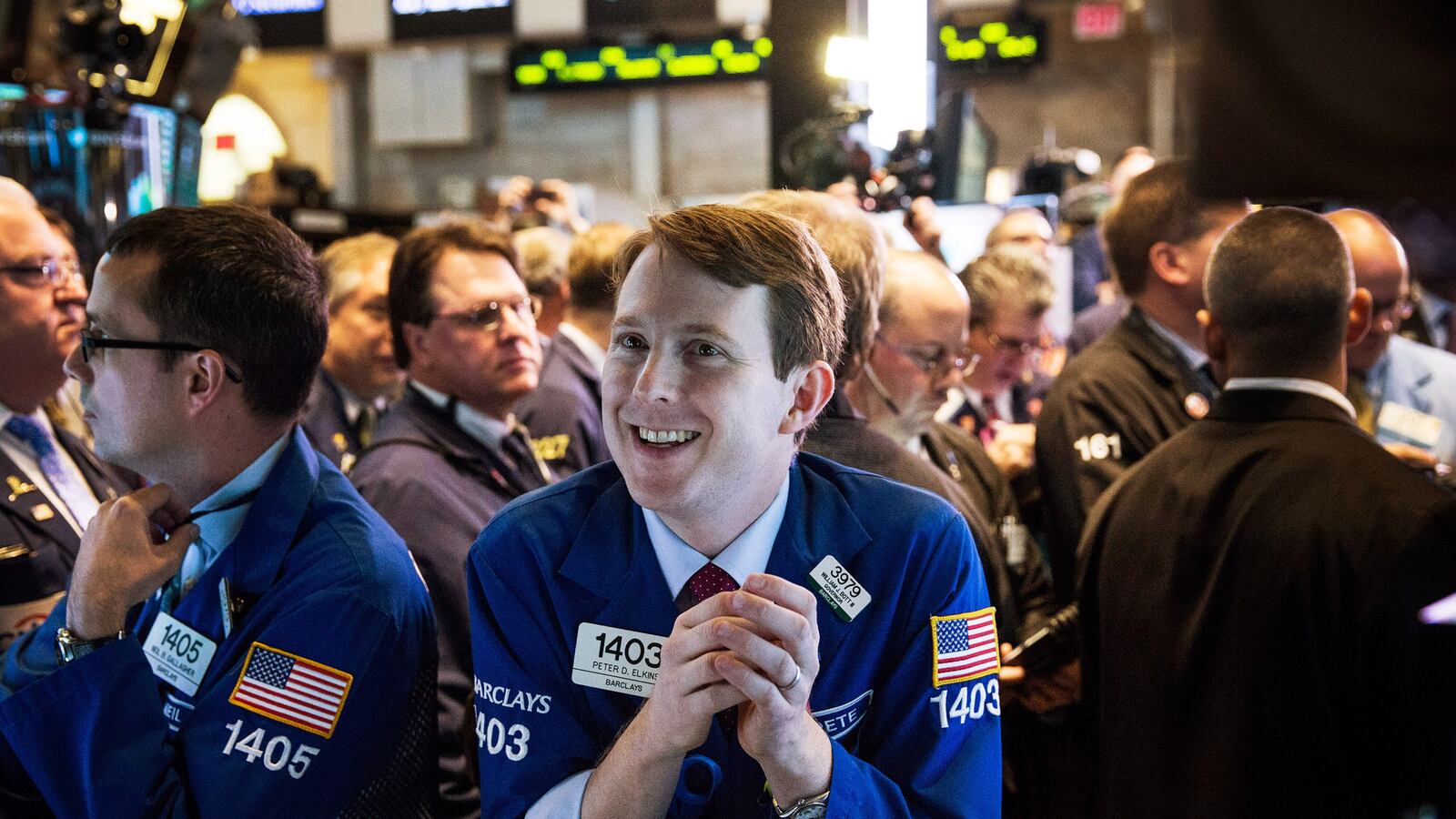The Standard & Poor’s 500 stands about 1766, near a record high. The Dow Jones Industrial Average is at about 15,727, also near a record high. Since the lows of March 2009, both indices are up nearly 140 percent.

Does President Obama deserve the credit? This was a question I was asked earlier this week on CNBC in a discussion with Reagan-era economist Art Laffer. The answer is: yes, but only some of it.
In general, I believe that efforts to pin stock market success (or failure) on political figures aren’t useful. That’s in part because much of the discussion, which is generally driven by those on the right side of the ideological spectrum, overlooks the historical record. Many market pundits hold as a foundational truth that bad things happen to markets and investors when Democrats control the White House and good things happen when Republicans run the show. They are, of course, wrong. Over the past century, markets have generally done better under Democratic presidents than under Republican ones. The worst crashes (1929, 1987, 2008) happened when Republicans were in office. And many of the greatest bull runs—the Nifty Fifty market of the 1960s, the boom of the 1990s, the current bull run—took place under Democrats. The dopes who dumped stocks in early 2009 fearful that President Obama would be bad for the stock market have missed one of history’s great rallies.
What’s more, policy and presidential rhetoric don’t really impact markets nearly as much as many analysts believe. The two administrations of George W. Bush, in theory, should have been a golden age for investors. Taxes on capital gains and dividends were slashed to very low levels, companies and financial institutions were lightly regulated, and labor unions were generally ignored. And yet the S&P 500 was about 35 percent lower on the day President Bush left office than on the day he entered office.
The historical rule tends to hold that presidents get credit for bad things that happen on their watch and for the good things that happen on their watch. But in the case of the stock market, I’d give Obama only a small percentage of the credit for the market boom— say 15 to 20 percent. The most important thing the Obama administration did for the economy—and for the markets—was to reverse the free fall of late 2008 and early 2009, stop the panic, and create the conditions for growth. The administration’s implementation and management of TARP and the auto and financial sector rescues, which began under the prior administration, were vital—and largely effective.
The stimulus passed in 2009, even though it was too small, added meaningfully to economic growth in 2009 and 2010. The economy began to expand in 2009. And even though it has been jolted and threatened by political actions—by Republican brinksmanship, by Obama’s inability to forestall crises, and by needless austerity—the U.S. economy has chugged along in low gear, adding more than 7 million jobs since early 2010. That’s not bad, but it’s not the kind of underlying growth that should lead the stock market to boom as it has.
So who else is responsible for the market boom? I’d give the Federal Reserve about 35-40 percent of the credit. Here’s why. The Fed, along with the Bush and Obama administrations, was an important actor in the bailouts. We tend to focus on TARP when looking back at the financial crises, but other, more obscure and underreported actions—the Fed’s guarantee of the commercial paper market, the Treasury’s guarantee of money-market funds, and the bailout of AIG—were just as important. Many of those were led by the Fed. And for the last several years, the Fed has attempted to goose the economy by keeping overnight interest rates at zero, and by purchasing bonds and mortgage-backed securities to push long-term rates down. These efforts at quantitative easing have helped stock markets in several intended and unintended ways. First, by pushing bond yields down to miniscule levels, the Fed has forced people seeking a return to plunge into riskier assets, like stocks. Second, the lower-rate environment has allowed many consumers to refinance mortgages and to gain access to lower-cost credit, which has freed up cash for other purchasers. That’s also good for stocks.
Third, and perhaps most significantly (and most overlooked) the low rates have been a boon to one of the factors that matters most for stock investors: corporate profits. Much of the press has focused on the way the financial sector has gorged itself and re-inflated thanks to free money provided by the Fed. That’s an important factor. But more broadly, the low interest-rate environment has been a gift to companies. They’ve been able to refinance their debt, or undertake new borrowings for investment or acquisitions, at extremely low levels. In May, for example, IBM sold $1.2 billion in seven-year bond at an interest rate of just 1.625 percent. In effect, the low interest rates engineered by the Fed have allowed big companies to reduce their overhead and improve profits margins.
So if Obama and the Fed between them get about half the credit, who gets the rest? Corporate America. In recent months, I’ve been down on big corporations for paying low wages and for running out of good ideas. But over the last several years, American companies, on the whole, have performed remarkably well. Some stocks may be performing in a bubble-like fashion (#Twitter). But the stock market overall isn’t a Fed-induced bubble. Or, rather, it isn’t only a Fed-induced bubble. The S&P 500 is trading at about 16 times the earnings of its constituent members, which is slightly elevated by historical standards but entirely reasonable. That is to say, the market has boomed so much in large measure because corporate profits have boomed so much. From $1.2 trillion in 2009, corporate profits have risen every year—hitting about $2 trillion in 2012. They’re up again so far in the first two quarters of 2013 (PDF).
Meanwhile, U.S. companies have never had more cash than they do today. And they’re using a portion of their hoard to buy back stock and pay dividends, which further supports stock prices. Amid all the howls of socialism and squeals of persecution, this has been a golden age for corporate profits.
Profits have been driven by several factors, which have little to do with President Obama. The easy money policies of the Fed have helped. What’ s more, in the U.S., capital has been beating the living daylights out of labor—in direct contravention of the stated policy preferences of the president. Corporate profits have never been higher, in absolute terms, and as a percentage of GDP. But workers’ share of national income has been steadily declining. In an America run by an alleged Socialist, in other words, shareholders and owners are keeping a higher portion of every dollar for themselves. This isn’t an outcome President Obama campaigned for, or wanted. But he hasn’t done much—beyond pro forma calls for minimum wage increases and a small amount of progressive tax increases—to remedy the situation.
Finally, and most significantly, stocks are soaring in part because American companies have found great success outside the U.S. It’s important to remember that stocks are a play on the global economy, especially big ones. According to Standard & Poor’s the typical member of the S&P 500 that reports non-U.S. sales separately from U.S. sales get about 46.6 percent of total sales from abroad. For the truly massive companies that populate the Dow Jones Industrial Average, the percentage is even higher. Indeed, for companies like McDonald’s, IBM, or Boeing, the U.S. is rapidly becoming a rump market. As a result, the political regime in their home base is largely irrelevant. And what we’ve seen in the last several years is that American companies have become very adept at exporting, getting into foreign markets, planting operations overseas, and acquiring foreign companies—anything to participate in global growth. General Motors now sells about as many cars in China as it does in the U.S. each year, with no assist from President Obama or Ben Bernanke.
Of course, listening to many business leaders and econo-pundits speak, you’d think the Obama years have been like the second coming of Stalin. It’s true that regulations and taxes are higher, and that the president doesn’t hold their hands and love-bomb them the way his predecessor did. Boo hoo! But the reality is that the last five years have been a fantastically good time to be a publicly held company, to be a CEO, and to be an investor in stocks.






